Hakone is a picturesque region nestled in the foothills of the majestic Mount Fuji.
Renowned for its natural beauty and soothing hot springs, Hakone offers visitors a captivating blend of tranquility and adventure.
Hakone is situated in the Fuji-Hakone-Izu National Park and most visitors come to admire the majestic views of Mount Fuji.
Day visitors from Tokyo tend to travel along the Hakone loop, a route that showcases many of the region’s sights. However, it is worth reserving a 2nd or 3rd day for this region. There is much more to experience in Hakone.
From the iconic Lake Ashi to the world-famous Hakone Open-Air Museum. Here are the best sights in the Hakone region.
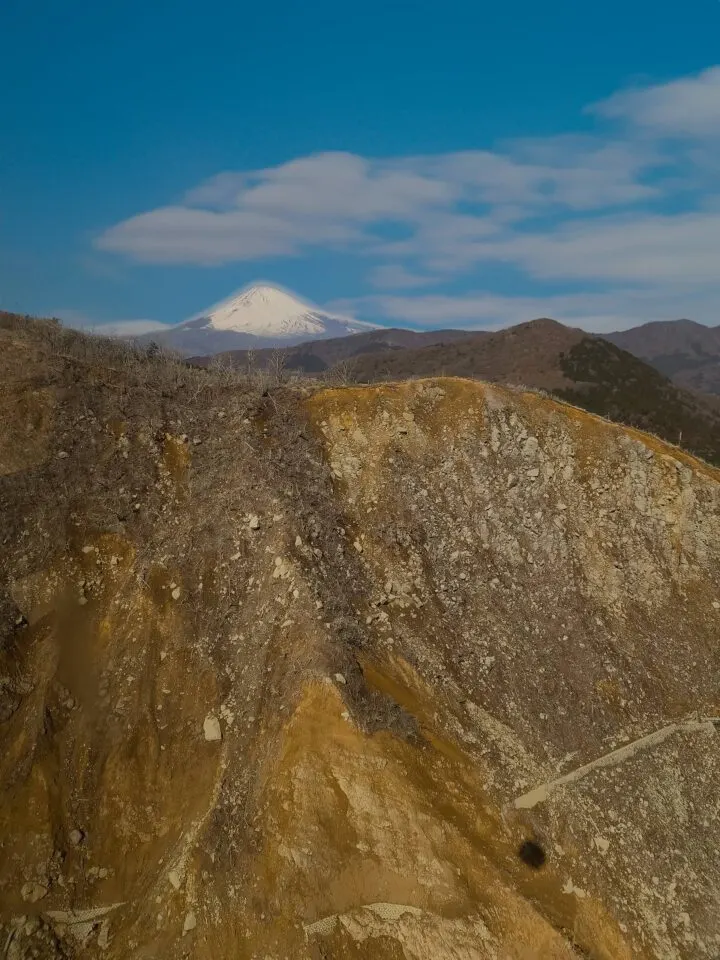
Best Places to see Mt. Fuji From Hakone
Hakone ropeway
On a clear day, you’ll be able to spot a scenic view of Mount Fuji as you ride the ropeway. You can see the mountain at the moment that you pass the Owakudani Valley, right before you reach the middle station. (see our picture above)
Moto Hakone
Moto Hakone, a village on the banks of Lake Ashi, is renowned for its views of Mt. Fuji. The volcano can be seen when you arrive at the port with the pirate ship cruise and also from the observation deck at the Onshi-Hakone-Koen park.
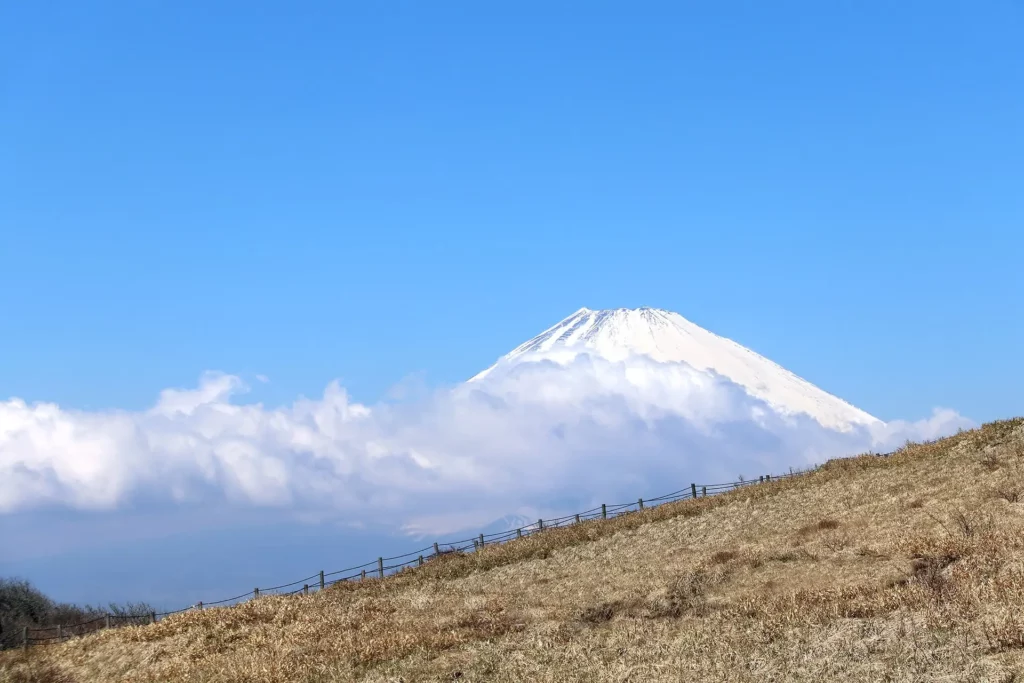
Mount Komagatake
Mount Komagatake sits on the bank of Lake Ashi. A ropeway takes you to the top where you find the Mototsumiya Shrine. However, most tourists who take the cable car up do not do so to visit the Shrine, but rather to enjoy the views of Mt. Fuji.
Mishima Skywalk
This is Japan’s longest footbridge. It was only built in 2015 and its primary purpose is to offer its visitors unsurpassed views.
Looking north, on clear days you can see Mt. Fuji. Towards the southwest, you have a view of the Suruga Bay along the Pacific coast.
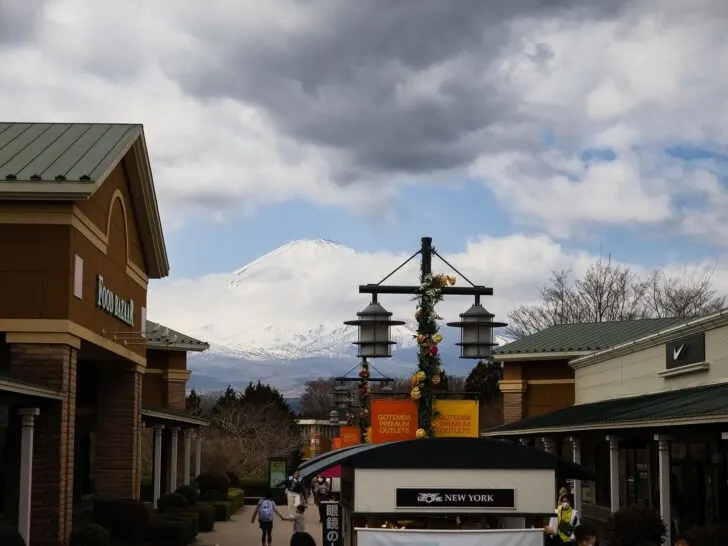
Gotemba Premium Outlets
This is without any doubt the best viewing spot for those shopaholics out there. Here you can shop and at the same time enjoy great views of Mount Fuji.
The Gotemba Premium Outlets are a good destination if you want to go shopping without feeling too guilty about not doing anything touristy.
Things to do in Hakone
Travel Along The Hakone Loop
The Hakone Loop is a tour that takes you past the most important sights in Hakone. It’s perfect as a 1-day itinerary and can be done as a day trip from Tokyo.
In our Hakone Loop Guide we discuss the course in detail.
Go Bathing in an Onsen
Hakone counts many hot springs thanks to its location near an area with volcanic activity. It has for centuries been a place where the Japanese came to relax and enjoy nature.
Most hot springs can be found in Hakone-Yumoto, the gateway to the Hakone region, but you can also find them in other parts of Hakone.
There are public bathhouses and you can also find them in hotels and ryokans. Some hotels and ryokans allow visitors into the onsen, while others reserve it for guests only.
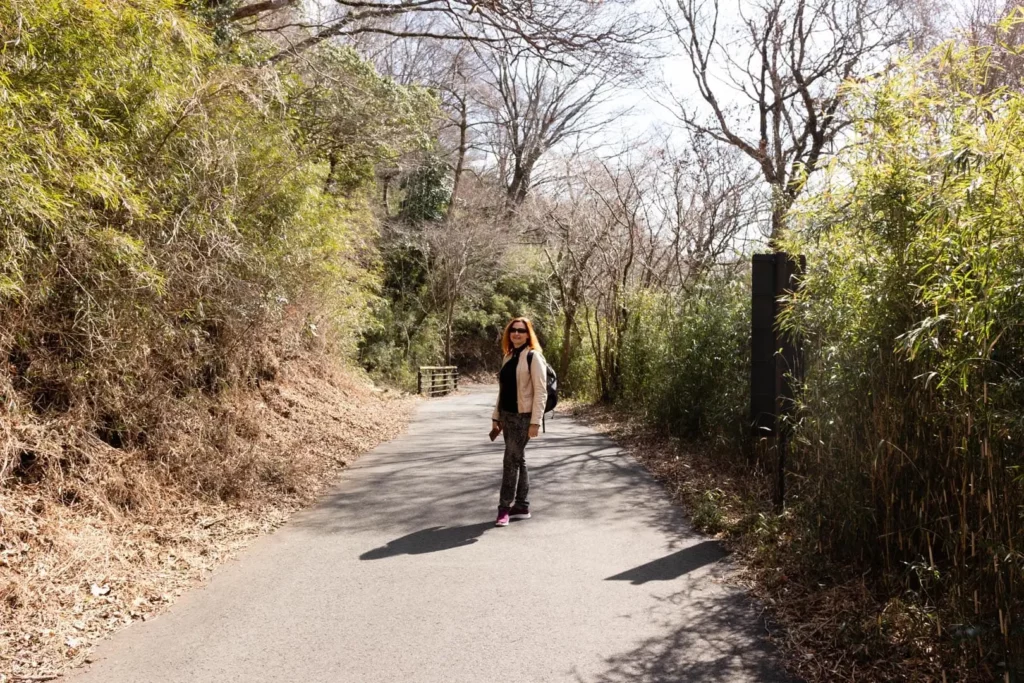
Hike at Lake Ashi
Hakone is a beautiful place to walk and fully enjoy the lush green scenery. There are different walks you can do depending on the time you have and your fitness level.
If you really want to get into nature, you can hike to the top of Mt. Kintoki or Mt. Myojingatake. At the top, you will be rewarded with sweeping views, including views of Mt Fuji.
If you have less time you can hike along the banks of the lake. The west bank course is the longest and most adventurous of the two. The east bank course is an easy walk that old and young can enjoy.
An advantage of walking along the eastern shore is that the trail takes you past many of the region’s top sights. First, you pass the Haruyuki Shrine, a bit of a hidden gem at Lake Ashi.
It is a serene shrine in a beautiful forested area that you can visit without the crowds of tourists that you find at the Hakone Shrine.
Then you pass the Komagatake ropeway and right before arriving at Moto-Hakone, you walk right past the iconic floating Torii gate of the Hakone Shrine.
Along the East Bank trail, you can hike from Togendai to Moto-Hakone in about 2 hours. (without stopping)
Ride the Hakone Ropeway
The Hakone Ropeway is part of the Hakone Loop. It takes you from the top station of the cable car to Lake Ashi. When the weather is good, the gondolas offer a beautiful view of Mt. Fuji.
The highlight of the trip is where the cable car goes over the volcanic Owakudani valley and you can see the active sulfur vents and muddy hot springs.
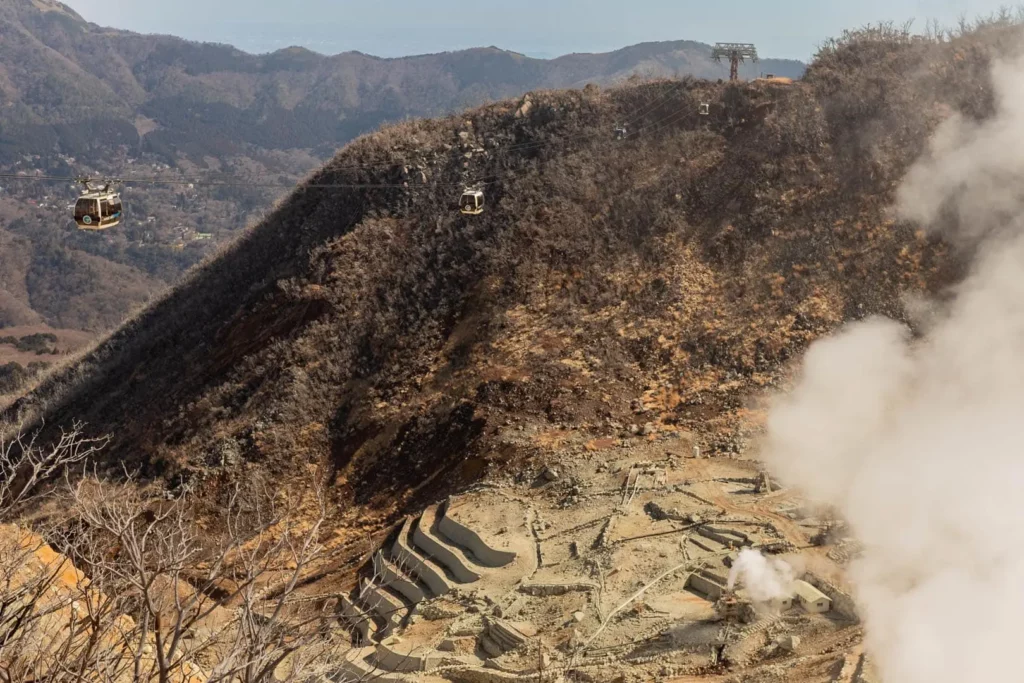
Visit the Owakudani Volcanic Valley
Get off at the middle station of the Hakone Ropeway to visit the Owakudani Valley.
From the terrace of the middle station you have a beautiful view over the volcanic valley and in good weather you can also see Mt Fuji.
You can take a short 40-minute guided walk in the volcanic area. It takes you close to the steam vents and bubbling mud pools. Advance reservations are required. There are 4 tours a day and the tour costs 500 JPY/person. It is not covered by the Hakone Freepass.
The famous Owakudani black eggs are sold at the souvenir shops at the middle station. The eggs are regular chicken eggs that have been boiled in the local hot springs. It is said that eating them extends your life for 7 years. It’s probably just a myth but it doesn’t harm to try….
Visit the Hakone Open Air Museum
The Hakone Open Air Museum is a captivating art destination where beautiful sculptures and other art pieces blend with the picturesque landscape that surrounds them.
The museum features a diverse collection of modern and contemporary artworks from both Japanese and international artists. Most outdoor exhibits are permanent while the indoor galleries have rotating exhibits of several different artists.
The Picasso Pavilion is one of the museum’s crowd-pleasers. The museum proudly boasts an impressive collection of 319 pieces by this world-renowned artist. Around 100 items are being exhibited at any given time.

Shop till you drop at the Gotemba Premium Outlets
The Gotemba Premium Outlet is one of the largest outlet malls in the country and attracts both domestic and international visitors seeking a premium shopping experience. It features a wide range of high-end international and domestic brands.
It is not only the low prices that make shopping here so pleasant. While shopping you can also enjoy the beautiful view of the imposing Mt. Fuji.
In addition, foreigners can shop tax-free at many stores, enjoying an additional discount on the prices shown.
Enjoy a Sightseeing Cruise on Lake Ashi
A sightseeing cruise on Lake Ashi is a picturesque way to explore the lush green lakeshore. The cruise is part of the Hakone Loop and every day many tourists make the crossing from Togendai to Moto-Hakone or vice versa.
A highlight of the cruise is the arrival at Moto-Hakone where you can see the iconic torii of the Hakone Shrine as well as the towering Mt. Fuji volcano.

Visit the Hakone Checkpoint
The Hakone Checkpoint, also known as Hakone Sekisho, used to be a crucial checkpoint during the Edo period. This was a time when the Tokugawa Shogunate imposed strict regulations on travel and trade between Kyoto and Edo (present-day Tokyo).
The Hakone Checkpoint underwent a three-year reconstruction process, which was finally completed in 2007. You can now admire the checkpoint as it would have looked back then, including all its essential features like officer and soldier housing, a lookout tower, and the Oshi-no-Go, or the “Pushing Pole Gate.” This gate was equipped with a mechanism that allowed officials to check the weight of cargo carried by travelers.
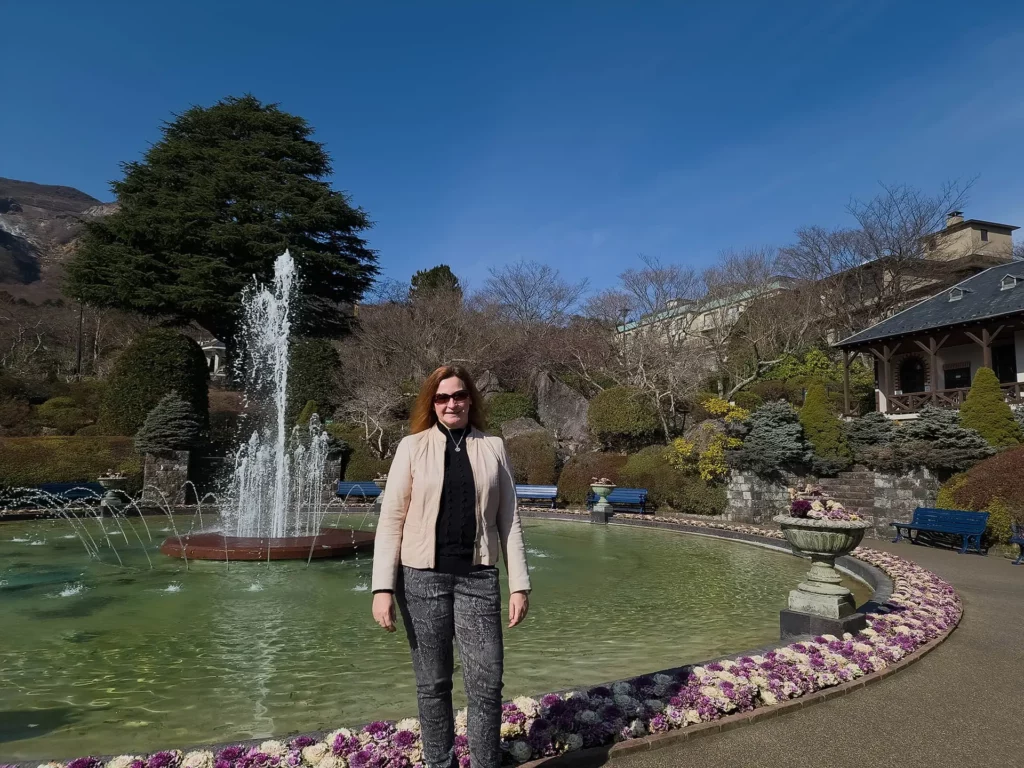
Admire the flowers in Gora Park
Gora Park is a picturesque and serene garden located on the steep slope above Gora station. The French style of the garden is clearly recognizable, and at the center of the park, you find a beautiful water feature with a fountain.
Yet a small part of the park is also in traditional Japanese style with a tea house.
It’s worth visiting the park for its many colorful flower beds and the stunning rose garden.
Walk across the Mishima Skywalk
The Mishima Skywalk stretches for approximately 400 meters and that makes it the largest pedestrian-only suspension bridge in the country.
On clear days it offers views of Mount Fuji to the north and Suruga Bay to the southwest. You will enjoy the best views in the early hours and late in the day, around sunset.
There’s also an adventure park at the skywalk with many activities for thrill seekers such as a zip line and treetop parcours.
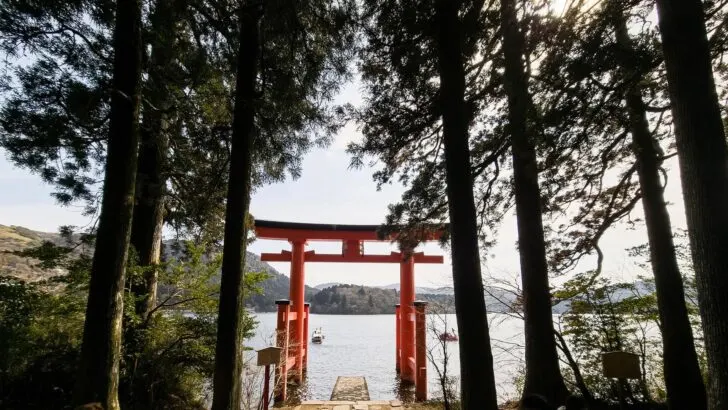
Hakone Shrine
Heiwa No Torii, the floating torii gate of the Hakone Shrine, is the symbol of Lake Ashi. Everyone wants to take selfies posing in front of this photogenic torii gate.
From the gate, a long flight of stairs leads up to the Honden, the main Shrine building, an elegant structure adorned with vibrant red vermillion paint and intricate woodwork.
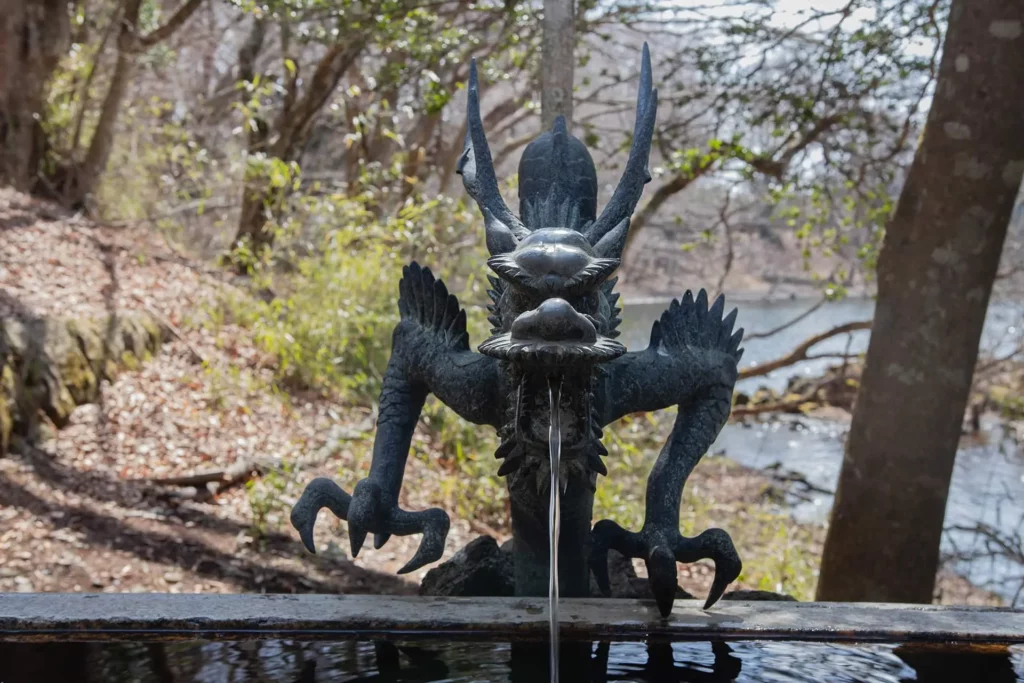
Relax at Hakuryu Shrine
The Hakuryu Shrine could be the hidden gem in the Hakone area. Hidden in the forests along the lake and without direct access by any form of public transport, this serene shrine is skipped by many tourists.
The lack of crowds so typical for the Hakone Shrine, allowed us to enjoy the leisurely walk along the serene pathway lined by towering cedar trees.
The main shrine building is a typical example of traditional Japanese architecture with its elegant yet minimalist design. Opposite the main building is a small floating torii gate located in Lake Ashi.

Visit Odawara Castle
Odawara Castle is a magnificent imposing castle, originally built in the 15th century. It stands proudly on a hilltop overlooking the city of Odawara.
Surrounding the castle, is a beautiful park with colorful cherry blossoms in the spring and vibrant foliage in the autumn.
Best Time to Visit Hakone
Hakone enjoys slightly milder temperatures than Tokyo. That is also one of the reasons why this area has become so popular.
Hakone can be visited all year round, but autumn and winter are the most popular seasons.
Winter is popular because it is the best season to see Mt. Fuji. It has the most clear and sunny days and thus a lower risk of Mt. Fuji being obscured by clouds. After a cold wintry day, you can warm up in the wonderful onsen.
During autumn, the region is transformed into a spectacular color palette of red and yellow. You can admire the autumn foliage from the train on the way to Gora and you can take a pleasant autumn walk along the shore of lake Ashi.
To a lesser extent, spring is also a great time to see the cherry blossoms. Due to the height difference (Hakone is a mountainous area), the trees bloom at different times. The blossoms first appear in the Hakone-Yumote area somewhere during April. Gora will follow somewhat later and finally Lake Ashi.
Many Tokyo residents come to Hakone in the summer to escape the heat in the capital. Summer traditionally starts with a week-long festival with music and fireworks.
How to Get to Hakone
Hakone is less than 100km from Tokyo. Most people visit it as a side trip from Tokyo. It takes about 2 hours to get there, by bus or train.
By bus: There are several daily buses from Shinjuku Station to Hakone. The bus is operated by Okdakyu and costs 2,240 JPY.
By train: If you travel by train, you can use discount passes to make the journey a bit cheaper. With a JR pass you can ride JR trains until Odaware where you will need to change to the Odakyu line. The nationwide JR pass covers the Tokaido Shinkansen, with other JR passes you can use the regular Tokaido Line or the Limited Express Odoriko.
If you don’t have a JR pass you can use the Odakyu trains to get from Tokyo to Hakone. In that case, we suggest buying a Hakone Freepass. The pass covers the return trip to Tokyo and a wide range of transport in the Hakone region, including the popular Hakone Loop.
With the pass, you are guaranteed to save money when you visit Hakone. Here you will find more information about the pass, including how much you can save.
Book your Hakone Freepass:
Buy on Klook